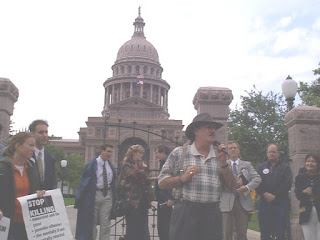 |
| Randall Dale Adams in 2001 Calling for a Moratorium on Executions in Texas |
On June 22, we blogged about the death of Texas death row exoneree Randall Dale Adams. Randall will be missed. He was someone who could bear personal witness about the injustice of the Texas death penalty. The power of his voice was evident in 2001 when he testified to a committee in the Texas Legislature for a moratorium bill, helping to convince the committee to vote in favor of stopping executions and studying the system.
The news of Randall’s death was picked up by the AP, which said:
“Adams did such a good job of disappearing that his Oct. 30 death from a brain tumor didn’t become widely known until Friday, when it was reported by the Dallas Morning News. (His former attorney) Randy Schaffer confirmed his former client’s death after speaking to his family. Adams was 61.”
Now, the New York Times has a long story about Randall, who died in October 2010. Condolences, memories and tributes can be left here.
Randall Adams, 61, Dies; Freed With Help of Film
By DOUGLAS MARTIN, New York Times
In 2001, Randall Dale Adams testified to a committees in the Texas House and Senate and told his story of how he was wrongfully convicted and sentenced to Texas death row. His testimony helped convince the committees to vote in favor of a moratorium on executions. Later in 2001, 53 members of the Texas House voted for a moratorium on the floor of the Texas House in a bill filed by Rep Harold Dutton.
This year in 2011, the House Committee on Criminal Jurisprudence again considered a bill for a moratorium on executions, but the committee took no action on the bill. Maybe if the committee members had been able to hear from Randall Adams they would have voted for a moratorium.







